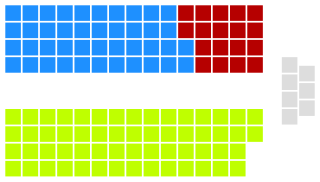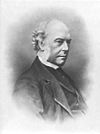Members of the New South Wales Legislative Assembly who served in the first parliament of New South Wales held their seats from 1856 to 1858. The Speaker was Sir Daniel Cooper.
Members of the New South Wales Legislative Assembly who served in the second parliament of New South Wales held their seats from 1858 to 1859. The Speaker was Sir Daniel Cooper.

The 1891 New South Wales colonial election was held in the then colony of New South Wales between 17 June to 3 July 1891. This election was for all of the 141 seats in the New South Wales Legislative Assembly and it was conducted in 35 single-member constituencies, 20 2-member constituencies, 10 3-member constituencies and nine 4-member constituencies, all with a first past the post system. Part 1 of the Electoral Act of 1880 set the qualification for election on "every male subject of Her Majesty of the full age of twenty-one years and absolutely free being a natural born or naturalized subject". Seven seats were uncontested. The previous parliament of New South Wales was dissolved on 6 June 1891 by the Governor, The Earl of Jersey, on the advice of the Premier, Sir Henry Parkes.

The 1895 New South Wales colonial election was held on 24 July 1895 for all of the 125 seats in the 17th New South Wales Legislative Assembly and it was conducted in single-member constituencies with a first past the post voting system. Section 23 (1) of the Parliamentary Electorates and Elections Act of 1893 conferred a right to vote on 'every male person, being a natural born [British] subject, who shall have resided or had his principal place of abode in New South Wales for a continuous period of one year'. males. The 16th parliament of New South Wales was dissolved on 5 July 1895 by the Governor, Lord Hampden, on the advice of the Premier, George Reid.

The 1889 New South Wales colonial election was held between 1 February and 16 February 1889. This election was for all of the 137 seats in the New South Wales Legislative Assembly and it was conducted in 37 single-member constituencies, nineteen 2-member constituencies, ten 3-member constituencies and eight 4-member constituencies, all with a first past the post system. Part 1 of the Electoral Act of 1880 had awarded the right to vote to 'every male subject of Her Majesty of the full age of twenty-one years and absolutely free being a natural born or naturalized'. The previous parliament of New South Wales was dissolved on 19 January 1889 by the Governor, Lord Carrington, on the advice of the Premier, George Dibbs.

The 1887 New South Wales colonial election was held between 4 February and 26 February 1887. This election was for all of the 124 seats in the New South Wales Legislative Assembly and it was conducted in 37 single-member constituencies, 23 2-member constituencies, seven 3-member constituencies and five 4-member constituencies, all with a first past the post system. Part 1 of the Electoral Act of 1880 had awarded the right to vote to 'every male subject of Her Majesty of the full age of twenty-one years and absolutely free being a natural born or naturalized'. The previous parliament of New South Wales was dissolved on 26 January 1887 by the Governor, Lord Carrington, on the advice of the Premier, Sir Henry Parkes.
The 1885 New South Wales colonial election was held between 16 October and 31 October 1885. This election was for all of the 122 seats in the New South Wales Legislative Assembly and it was conducted in 37 single-member constituencies, 24 2-member constituencies, seven 3-member constituencies and four 4-member constituencies, all with a first past the post system. Suffrage was limited to adult male British subjects, resident in New South Wales. The previous parliament of New South Wales was dissolved on 7 October 1885 by the Governor, Lord Augustus Loftus, on the advice of the Premier, George Dibbs.
The 1882 New South Wales colonial election was held between 30 November and 21 December 1882. This election was for all of the 113 seats in the New South Wales Legislative Assembly and it was conducted in 40 single-member constituencies, 26 2-member constituencies, three 3-member constituencies and three 4-member constituencies, all with a first past the post system. Suffrage was limited to adult male British subjects, resident in New South Wales. The previous parliament of New South Wales was dissolved on 23 November 1882 by the Governor, Lord Augustus Loftus, on the advice of the Premier, Sir Henry Parkes.
The 1880 New South Wales colonial election was held between 17 November and 2 December 1880. This election was for all of the 108 seats in the New South Wales Legislative Assembly and it was conducted in 43 single-member constituencies, 25 2-member constituencies, one 3-member constituency and three 4-member constituencies, all with a first past the post system. Suffrage was limited to adult white males. The previous parliament of New South Wales was dissolved on 9 November 1880 by the Governor, Lord Augustus Loftus, on the advice of the Premier, Sir Henry Parkes.
The 1877 New South Wales colonial election was held between 24 October and 12 November 1877. This election was for all of the 73 seats in the New South Wales Legislative Assembly and it was conducted in 53 single-member constituencies, six 2-member constituencies and two 4-member constituencies, all with a first past the post system. Suffrage was limited to adult male British subjects, resident in New South Wales. The previous parliament of New South Wales was dissolved on 12 October 1877 by the Governor, Sir Hercules Robinson, on the advice of the Premier, Sir John Robertson.
The 1874–75 New South Wales colonial election was held between 8 December 1874 and 12 January 1875. This election was for all of the 72 seats in the New South Wales Legislative Assembly and it was conducted in 52 single-member constituencies, six 2-member constituencies and two 4-member constituencies, all with a first past the post system. Suffrage was limited to adult white males. The previous parliament of New South Wales was dissolved on 28 November 1874 by the Governor, Sir Hercules Robinson, on the advice of the Premier, Henry Parkes.
The 1872 New South Wales colonial election was held between 13 February and 28 March 1872. This election was for all of the 72 seats in the New South Wales Legislative Assembly and it was conducted in 52 single-member constituencies, six 2-member constituencies and two 4-member constituencies, all with a first past the post system. Suffrage was limited to adult white males. The previous parliament of New South Wales was dissolved on 3 February 1872 by the Governor, Lord Belmore, on the advice of the Premier, Sir James Martin.
The 1869–70 New South Wales colonial election was held between 3 December 1869 and 10 January 1870. This election was for all of the 72 seats in the New South Wales Legislative Assembly and it was conducted in 52 single-member constituencies, six 2-member constituencies and two 4-member constituencies, all with a first past the post system. Suffrage was limited to adult white males. The previous parliament of New South Wales was dissolved on 15 November 1869 by the Governor, Lord Belmore, on the advice of the Premier, John Robertson.
The 1864–65 New South Wales colonial election was held between 22 November 1864 and 10 January 1865. This election was for all of the 72 seats in the New South Wales Legislative Assembly and it was conducted in 52 single-member constituencies, six 2-member constituencies and two 4-member constituencies, all with a first past the post system. The previous parliament of New South Wales was dissolved on 10 November 1864 by the Governor, Sir John Young, on the advice of the Premier, James Martin. Suffrage was limited to adult white males.
The 1860 New South Wales colonial election was held between 6 December and 24 December 1860. This election was for all of the 72 seats in the New South Wales Legislative Assembly and it was conducted in 52 single-member constituencies, six 2-member constituencies and two 4-member constituencies, all with a first past the post system. Suffrage was limited to adult white males. This was the first election after the separation of Queensland in December 1859.
The 1859 New South Wales colonial election was held between 9 June and 7 July 1859. This election was for all of the 80 seats in the New South Wales Legislative Assembly and it was conducted in 58 single-member constituencies, seven 2-member constituencies and two 4-member constituencies, all with a first past the post system. Suffrage was limited to adult white males. The previous parliament of New South Wales was dissolved on 11 April 1859 by the Governor, Sir William Denison, on the advice of the Premier, Charles Cowper.
The 1856 New South Wales colonial election was held between 11 March and 19 April 1856. This election was for all of the 54 seats in the New South Wales Legislative Assembly and it was conducted in 18 single-member constituencies, 13 2-member constituencies, two 3-member constituencies and one 4-member constituency, all with a first past the post system.
The 1858 New South Wales colonial election was to return 54 members of Legislative Assembly composed of 34 electoral districts with 18 returning 1 member, 13 returning 2 members, two returning 3 members and one returning 4 members, all with a first past the post system. In multi-member districts, because each voter could cast more than one vote, it is not possible to total the votes to show the number of voters and voter turnout in these districts is estimated. 17 members from 14 districts were returned unopposed. The electoral districts and boundaries were established under the Electoral Act 1851 (NSW) for the former Legislative Council.
Sydney Hamlets, an electoral district of the Legislative Assembly in the Australian state of New South Wales, had two incarnations, from 1950 until 1971 and from 1988 until 1999.
The 1851 New South Wales colonial election was held between 12 and 25 September. This election was for 36 seats in the New South Wales Legislative Council. The 1848 election had been for 5 year terms however the parliament had been reconstituted following the separation of Victoria. At the same time the council was expanded from 36 to 54 members. The Legislative Council was a hybrid system with 18 appointed members and 36 elected. The Port Philip districts had 6 elected members, which meant there were an additional 18 seats. There were 3 new districts for the northern regions of what would later become Queensland, Stanley, Stanley Boroughs and the pastoral districts of Moreton, Wide Bay, Burnett, and Maranoa and 7 new pastoral districts in western New South Wales. The other 8 additional seats were distributed among the nineteen counties of New South Wales.




